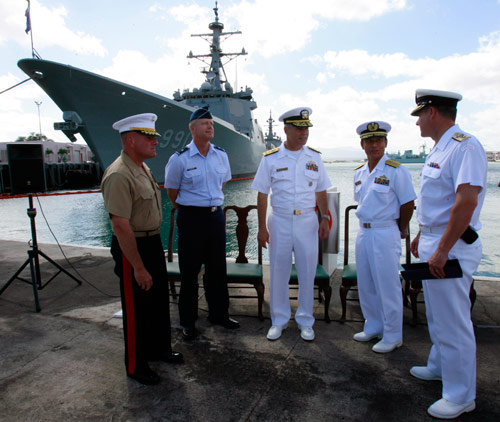Sub training ends RIMPAC

Military brass conversed after holding a press conference yesterday at Pearl Harbor regarding the Rim of the Pacific exercises. Pictured are Marine Corps Brig. Gen. John Broadmeadow, left, Air Force Brig. Gen. Thomas Harwood, Navy Vice Adm. Richard Hunt, Japanese Maritime Self Defense Force Rear Adm. Kazuki Yamashita and Canadian Navy Rear Adm. Ron Lloyd. In the background is the Republic of Korea Navy's DDG 991 Sejong, which was participating in RIMPAC. Closing ceremonies for RIMPAC will be held tomorrow.
Country "Orange" ignores all diplomatic and political requests to cease operations in country "Green," and a sea battle ensues.
That was the framework for the final "free play" tactical phase of Rim of the Pacific war games Sunday through yesterday as the big 40-day maritime exercise wraps up in Hawaii waters.
RIMPAC is advertised as interoperability practice between allied nations, but real-world threats are never far behind.
Diesel electric submarines from Japan and South Korea stalked the U.S. aircraft carrier Ronald Reagan in the final phase — simulating a growing undersea worry as nonallied nations build up their stock of quiet subs in the Pacific.
Speaking to reporters yesterday, U.S. Navy Vice Adm. Richard Hunt said the training encounters were still being reviewed, "but I will say that the Reagan did very well — moved quickly and smartly out there at sea."
He added, "The diesels (submarines) that came are incredibly capable and presented tremendous challenges throughout the exercise. (They) provided some of the best training that we had."
Don't miss out on what's happening!
Stay in touch with breaking news, as it happens, conveniently in your email inbox. It's FREE!
Another U.S. aircraft carrier, the George Washington, was at the center of war games off the east coast of South Korea this past week as a reproach to North Korea.
Adm. Robert Willard, head of U.S. Pacific Command at Camp Smith, said July 20 in South Korea that future exercises would be held in international waters in the West Sea (or Yellow Sea) west of South Korea, which China considers to be on its doorstep, as the U.S. seeks to maintain its reach in the region.
The U.S. Navy downplayed RIMPAC yesterday in the context of world events.
"RIMPAC is something that we do every two years. It’s two years in planning, and we truly have been working this in detail for the last 12 months," Hunt said. "What we are trying to accomplish with RIMPAC is training for ourselves, not necessarily sending a message, but training preparedness."
Hunt and other senior officers from the U.S., Japan and Canada spoke pierside at Pearl Harbor in front of the South Korean destroyer Sejong the Great and the Japanese destroyers Atago and Akebono.
The 32 ships participating in this year’s RIMPAC started pulling back into Pearl Harbor yesterday, officials said. Closing ceremonies for the exercise will be held tomorrow.
Five submarines, more than 170 aircraft and about 20,000 personnel took part in RIMPAC, which involved the Army, Navy, Air Force, Marine Corps and Coast Guard.
This year’s exercise included units or personnel from Australia, Canada, Chile, Colombia, France, Indonesia, Japan, Malaysia, the Netherlands, Peru, South Korea, Singapore, Thailand and the U.S.
The Navy also said there were three observer nations: Brazil, India and New Zealand.
Participating countries conducted gunnery, missile, torpedo, anti-submarine and air defense exercises as well as maritime interdiction and vessel boardings, explosive ordnance disposal, diving and salvage operations, mine clearance operations and amphibious landings.
The Marines experimented with beach landings involving smaller company forces of about 180 Marines versus a battalion landing team of about 1,100 Marines coming ashore. The goal was to evaluate dispersing Marines in wider areas.
"I won’t say it was a success across the board … but we learned some very, very important things from it," said Marine Corps Brig. Gen. John Broadmeadow. "As you take a smaller force, spread it over a wider area, you can imagine the command and control issues that you are going to have."




